PLACE
Jack The Ripper murder locations
LOCATION
London, England
AUTHOR
Articles and Pictures, Tony Hart-Wilden
HISTORY
Jack the Ripper committed his first murder on August 31st 1888. Although he claimed only four more victims, a body count that has been far exceeded by today’s serial killers, he remains a legend over a century later. But it was not the number of victims, or even the terrible mutilations that he carried out, that has caused his name to be whispered a hundred years later. But it is for bringing his horrific crimes into what was considered a civilized modern era, and for that he will be forever remembered as the worlds first serial killer. Able to evade Scotland Yard and the vigilante mobs that now roamed the gas lit streets of east London he was never caught. Speculation as to who he was ranges from a American doctor to a member of the British royal family. There have been countless books and television documentaries on the subject and even today researchers continue to look for answers. But the reality is that the winding alleyways of old London will forever hold their secrets.
To visit the many sites where Jack the Ripper once stalked London’s east end, there are two options. You can take one of the numerous organized tours or get a guide book and a map and visit the lo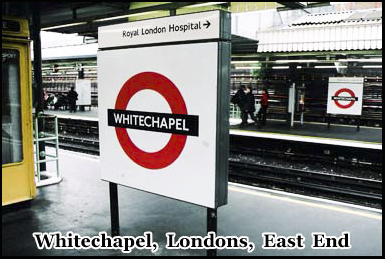 cations yourself. I did both, and although the organized group tour was informative, I would recommend visiting the area at your own pace. There are several official Jack the Ripper tours available and many operate every evening, leaving from either Tower Hill or Algate tube stations .The problem with them, is that it will be you, and possibly up to a hundred others, which means much of the atmosphere is already lost. And for serious picture taking, you will find it hard to take any without someone getting in the way, or running out of time to compose them. You will also find that you will be running into rival tour groups all trying to compete to show other people the same sites as the one your on. During the summer there can be up to two or three hundred people all visiting the same places in what is, in many parts, still a residential area. This has led to many complaints by the people living there against the disruption it has caused.
cations yourself. I did both, and although the organized group tour was informative, I would recommend visiting the area at your own pace. There are several official Jack the Ripper tours available and many operate every evening, leaving from either Tower Hill or Algate tube stations .The problem with them, is that it will be you, and possibly up to a hundred others, which means much of the atmosphere is already lost. And for serious picture taking, you will find it hard to take any without someone getting in the way, or running out of time to compose them. You will also find that you will be running into rival tour groups all trying to compete to show other people the same sites as the one your on. During the summer there can be up to two or three hundred people all visiting the same places in what is, in many parts, still a residential area. This has led to many complaints by the people living there against the disruption it has caused.
However the main drawback with these tours is that being of a limited time in duration, they will only take you to two or three of the murder sites, not all of them. It will of course take a lot longer to visit all the related ripper locations, but if you are truly interested in Jack the 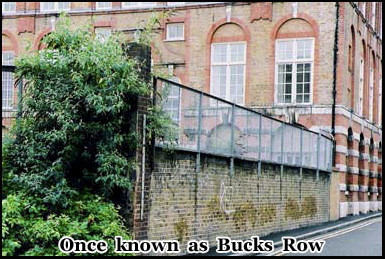 Ripper, you should make the time to do so. One thing I should mention for anyone expecting the East End of London, to still be a series of Victorian gas lit alleys shrouded in fog, it isn’t. Although, some parts still provide a small taste of old London, much of the area from the time of Jack the Ripper is gone. They were either slums, that were long since demolished, or buildings destroyed as a result of massive bombing during world war 2. But despite this, just to stand in the exact same places where these events happened over a hundred years ago is still a journey worth making. I began the trip outside the Whitechapel underground station, the first of the Ripper murder sites is just a few minutes walk away.If you step out onto the high street , you will see letters etched onto the building behind you, saying “Whitechapel”, which is the part of London most famous for its association with Jack the Ripper. Across the road is a old hospital which is from the same Victorian era, and you are now on Whitechapel High Street.
Ripper, you should make the time to do so. One thing I should mention for anyone expecting the East End of London, to still be a series of Victorian gas lit alleys shrouded in fog, it isn’t. Although, some parts still provide a small taste of old London, much of the area from the time of Jack the Ripper is gone. They were either slums, that were long since demolished, or buildings destroyed as a result of massive bombing during world war 2. But despite this, just to stand in the exact same places where these events happened over a hundred years ago is still a journey worth making. I began the trip outside the Whitechapel underground station, the first of the Ripper murder sites is just a few minutes walk away.If you step out onto the high street , you will see letters etched onto the building behind you, saying “Whitechapel”, which is the part of London most famous for its association with Jack the Ripper. Across the road is a old hospital which is from the same Victorian era, and you are now on Whitechapel High Street.
You will find on most days there is a long established street market held here. This part of London is now home to many members of the Bangladeshi community, and along one side there several fast food curry restaurants, newsagents and local shops. Walk along the street a few hundred yards then make a right and cross a bridge over the railway tracks. Then make another right, and ahead of you, 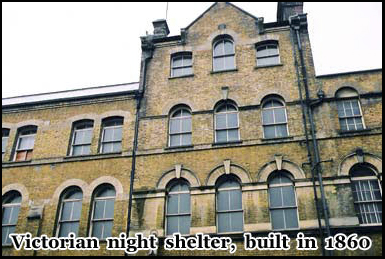 you will see a large red brick building with some wrought iron railings on the top. Built in 1860 it was once a school, and if you had been looking out of one of the top windows on the night of the 31st of August 1888 you may of seen Jack the Ripper dismembering his first victim just at the end of the brick wall running along its side . I headed down the narrow street in front of the building. There is a plaque on the wall that says Durward Street. This was actually once Bucks row, but soon after the murders were committed the residents petitioned to have the name changed to stop sight seers. I doubt they would have realized that a hundred years later, people would still be doing the same thing. I stopped where the brick wall ended, and there is a small parking lot.This was the location that at 3.40 am Mary Anne Nicholl’s was found, she had been disemboweled, and her throat slit. She was discovered by a Charles Cross and a companion, who immediately went off to look for a police officer to return to the scene with them . In the meantime the body was also discovered by another officer P.C John Neil.
you will see a large red brick building with some wrought iron railings on the top. Built in 1860 it was once a school, and if you had been looking out of one of the top windows on the night of the 31st of August 1888 you may of seen Jack the Ripper dismembering his first victim just at the end of the brick wall running along its side . I headed down the narrow street in front of the building. There is a plaque on the wall that says Durward Street. This was actually once Bucks row, but soon after the murders were committed the residents petitioned to have the name changed to stop sight seers. I doubt they would have realized that a hundred years later, people would still be doing the same thing. I stopped where the brick wall ended, and there is a small parking lot.This was the location that at 3.40 am Mary Anne Nicholl’s was found, she had been disemboweled, and her throat slit. She was discovered by a Charles Cross and a companion, who immediately went off to look for a police officer to return to the scene with them . In the meantime the body was also discovered by another officer P.C John Neil.
This is one of the few locations that there is a building from the same time period left at a murder site. And although the old school house has now been turned into apartments, it makes it a bit easier to turn your mind back a century and imagine the horror that both 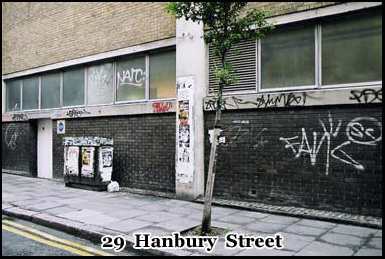 Charles Cross and the police officers must have felt upon seeing the blood stained corpse. I headed up Durward Street and back over the Whitechapel road. It is a considerable walk to the next of the murder sites, through a housing estate across Brick lane, and on to Hanbury Street . The back yard of number 29 was the murder site of Annie Chapman on September the 8th. This site is now the location of the Truman brewery, which itself has closed down. The only thing to see is an ugly concrete wall, covered with graffiti and fly posters. The other side of the street has a few buildings at one end from the Victorian era, but the street is unrecognizable from the time Annie Chapman meet her death. This was once a row of cheap boarding houses, and it was at 5.45 am when John Davis one of the other residents discovered the body.
Charles Cross and the police officers must have felt upon seeing the blood stained corpse. I headed up Durward Street and back over the Whitechapel road. It is a considerable walk to the next of the murder sites, through a housing estate across Brick lane, and on to Hanbury Street . The back yard of number 29 was the murder site of Annie Chapman on September the 8th. This site is now the location of the Truman brewery, which itself has closed down. The only thing to see is an ugly concrete wall, covered with graffiti and fly posters. The other side of the street has a few buildings at one end from the Victorian era, but the street is unrecognizable from the time Annie Chapman meet her death. This was once a row of cheap boarding houses, and it was at 5.45 am when John Davis one of the other residents discovered the body.
At the time so many so many people flocked to the murder site that owners of adjacent houses charged spectators for a better view of the crime scene. This is one of the stops on the official tours, and this part of the East End has now become quite sought after for people working in the nearby 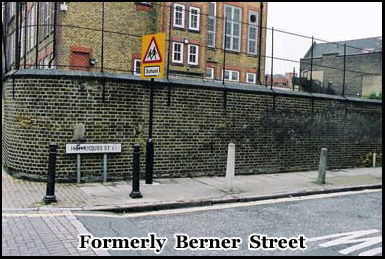 city financial center. Again there is a fairly long walk ahead to the location of the next murder, you have to go down Brick lane and back track over the Whitechapel Road . Brick lane is now famous for its curry restaurants, but it also has some good market stalls and interesting pubs and bars. There is even a old time music hall at one end, and the area has retained some of its unique character among the more modern day London landscape. One point of interest before you get to the next destination is what is now known as Mulberry Street . In 1888 it was known as Zion square, and at one time a man by the name of Severin Kosminski lived there. He is consistently listed as one of the key people suspected of being Jack the Ripper. From here I crossed over Commercial Road , and came to Henriques Street .
city financial center. Again there is a fairly long walk ahead to the location of the next murder, you have to go down Brick lane and back track over the Whitechapel Road . Brick lane is now famous for its curry restaurants, but it also has some good market stalls and interesting pubs and bars. There is even a old time music hall at one end, and the area has retained some of its unique character among the more modern day London landscape. One point of interest before you get to the next destination is what is now known as Mulberry Street . In 1888 it was known as Zion square, and at one time a man by the name of Severin Kosminski lived there. He is consistently listed as one of the key people suspected of being Jack the Ripper. From here I crossed over Commercial Road , and came to Henriques Street .
Again the street name has been changed from the name it had during the Victorian era. I’m not sure if in this instance like Bucks row, it was as a result of its association with Jack the Ripper, but in this case it does say that it was formerly Berner Street . There is a shop on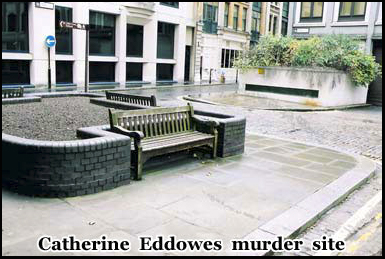 the corner, and up ahead it is just a short walk to the intersection of Fairclough Street . The area across the road is another housing estate. But on the right hand side is what looks like a school yard. It was at this corner that Liz Stride was found at about 1 am on 30th September 1888 .The international working mans club once stood here, and it was the club steward Loise Diemschutz that discovered her. Although the police believed this to be the third murder by jack the ripper, her throat had been slit but she had not been severely mutilated like the previous two bodies. Detectives came to the conclusion that the murderer had been disturbed before he could finish his work. However this was the first of two murders that the Ripper was to carry out that night. The second is about another twenty minutes walk away in Mitre Square.
the corner, and up ahead it is just a short walk to the intersection of Fairclough Street . The area across the road is another housing estate. But on the right hand side is what looks like a school yard. It was at this corner that Liz Stride was found at about 1 am on 30th September 1888 .The international working mans club once stood here, and it was the club steward Loise Diemschutz that discovered her. Although the police believed this to be the third murder by jack the ripper, her throat had been slit but she had not been severely mutilated like the previous two bodies. Detectives came to the conclusion that the murderer had been disturbed before he could finish his work. However this was the first of two murders that the Ripper was to carry out that night. The second is about another twenty minutes walk away in Mitre Square.
Although he was credited with five official murders, there are actually several others that many believe Jack the Ripper was responsible for, most in the same part of the East End. There are many 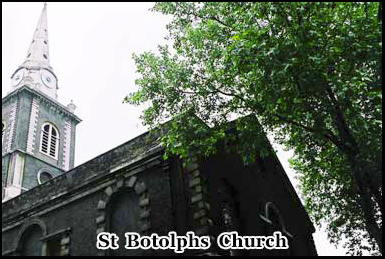 books and internet sites that support these theories, but like the Ripper’s true identity we will probably never know. I began my walk over to Mitre Square where Catherine Eddowes was murdered. Shortly before you get there Saint Botolphs church still stands.The church is famous for being both haunted, and also as a place where some of the prostitutes that where the Rippers victims used to solicit from. As you pass it, you will notice that drunks and homeless people still seem to congregate around its steps. Just past here, you come to the subway that will take you to any one of about a dozen different exists under the street. It is an dark underground warren of blind turns and it would be best to avoid crossing the road this way at night if you can. On the other side of the street and down an alleyway you come to Mitre Square.
books and internet sites that support these theories, but like the Ripper’s true identity we will probably never know. I began my walk over to Mitre Square where Catherine Eddowes was murdered. Shortly before you get there Saint Botolphs church still stands.The church is famous for being both haunted, and also as a place where some of the prostitutes that where the Rippers victims used to solicit from. As you pass it, you will notice that drunks and homeless people still seem to congregate around its steps. Just past here, you come to the subway that will take you to any one of about a dozen different exists under the street. It is an dark underground warren of blind turns and it would be best to avoid crossing the road this way at night if you can. On the other side of the street and down an alleyway you come to Mitre Square.
Although some of the squares original cobblestones remain, it is now surrounded on all sides by office blocks. This is one of the other stops you will go to on the official Ripper tours. It was here where the bench and flowerbed now stand that also on the night of September the 30th 1888 Catherine Eddowes body was found. At around 1.30 am a P.C Watkins di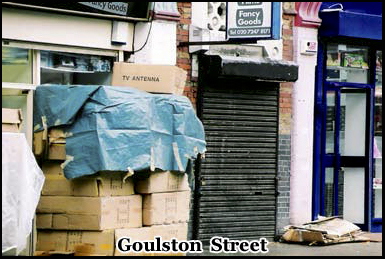 scovered the rippers 4th victim. Her kidney had been removed, her stomach slashed open, her throat slit, and her face mutilated. Like the other Ripper murder sites there is nothing to indicate what happened here, and I’m sure people sit on the bench everyday eating lunch oblivious to what once took place. I headed across the square and made a right turn down Mitre passage, which is the path the ripper was believed to have taken after he committed this particular murder. It’s about another fifteen minutes walk across what is now London’s financial district to the final murder site. It is worth remembering that what is now one of the world’s business centers was once nothing but Victorian slums. Thousands of people would be living in poverty on what where filthy disease ridden streets. But that has long since changed and indeed many parts of the East End are considered fashionable trendy places to live by London’s current inhabitants. I finally got to Goulston Street and it had started to rain.
scovered the rippers 4th victim. Her kidney had been removed, her stomach slashed open, her throat slit, and her face mutilated. Like the other Ripper murder sites there is nothing to indicate what happened here, and I’m sure people sit on the bench everyday eating lunch oblivious to what once took place. I headed across the square and made a right turn down Mitre passage, which is the path the ripper was believed to have taken after he committed this particular murder. It’s about another fifteen minutes walk across what is now London’s financial district to the final murder site. It is worth remembering that what is now one of the world’s business centers was once nothing but Victorian slums. Thousands of people would be living in poverty on what where filthy disease ridden streets. But that has long since changed and indeed many parts of the East End are considered fashionable trendy places to live by London’s current inhabitants. I finally got to Goulston Street and it had started to rain.
The area now changes back into street markets, curry restaurants and small shops selling cheap electrical goods, and clothing. Next to one of the shops was once a doorway where a clue, possibly written by jack the ripper was left. It read “the juwes are the men that will not be blamed for nothing”. There has been much speculation as to if this was a misspelling of the word Jews, many of which lived in the East End at the time. Also along Goulston street was found one of the few pieces of physical evidence left by the Ripper. It was a piece of Catherine Eddowes blood stained apron. It 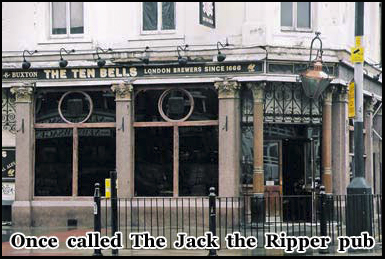 was believed to have been discarded after the ripper used it to clean his hands and wipe the blade of his knife. I headed on down what is now Bell lane. The site of the last murder was at Millers Court a passageway off of Dorset Street .As you approach the area you will notice a huge Victorian building on one side of the road, this was once a night shelter and was built in 1860. Across from there is a small alleyway by an office building, next to that is a multi story car park. It is somewhere in the center of the car park where on the night of November the 8th Mary Kelly was murdered. The mutilations carried out on her were by far the most gruesome.
was believed to have been discarded after the ripper used it to clean his hands and wipe the blade of his knife. I headed on down what is now Bell lane. The site of the last murder was at Millers Court a passageway off of Dorset Street .As you approach the area you will notice a huge Victorian building on one side of the road, this was once a night shelter and was built in 1860. Across from there is a small alleyway by an office building, next to that is a multi story car park. It is somewhere in the center of the car park where on the night of November the 8th Mary Kelly was murdered. The mutilations carried out on her were by far the most gruesome.
Part of the reason for this is that the Ripper was hidden from view in the room of a lodging house, as opposed to being out in the open like the previous murders. In this instance it provided him with enough time to cut out the victim’s entrails, and place them by a table next to the bed. The body was discovered by a Thomas Bowyer who alerted the police. There are a few other stops on the Ripper trail that you should make. One of them is the Ten Bells pub in Whitechap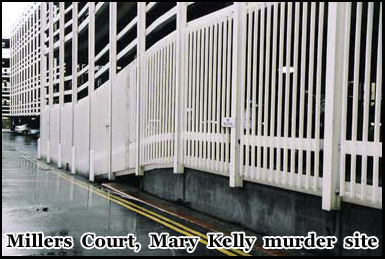 el. This was at one time called the Jack the Ripper pub, but it has now reverted to its original name of the ten bells. This and the Britannia pub that once stood at the end of Dorset Street were some of the most popular pubs in the area at the time of the Ripper murders and without doubt were places where some of his victims must have had a few last drinks. Right across the street from it is the famous Smithfield market which was one of the main employers in the area in Victorian times, and is still operates today. From the Ten bells I had planned to visit the graves of two of the Rippers victims. If you walk back to nearby Liverpool street station you can catch a train to Manor Park which is where the City of London cemetery is. The train ride is about twenty minutes. I exited Manor Park station and made a left turn along the main road, it was about a fifteen minute walk to the cemetery entrance. It is still in use, and is one of London’s largest.
el. This was at one time called the Jack the Ripper pub, but it has now reverted to its original name of the ten bells. This and the Britannia pub that once stood at the end of Dorset Street were some of the most popular pubs in the area at the time of the Ripper murders and without doubt were places where some of his victims must have had a few last drinks. Right across the street from it is the famous Smithfield market which was one of the main employers in the area in Victorian times, and is still operates today. From the Ten bells I had planned to visit the graves of two of the Rippers victims. If you walk back to nearby Liverpool street station you can catch a train to Manor Park which is where the City of London cemetery is. The train ride is about twenty minutes. I exited Manor Park station and made a left turn along the main road, it was about a fifteen minute walk to the cemetery entrance. It is still in use, and is one of London’s largest.
I first tried to find the victims graves by looking for some sort of sign posting, as I knew they were  somewhere in the region known as the memorial gardens. There are some very ornate old Victorian tombs in the cemetery, and also a semi-circle of catacombs in the middle that are worth seeing if you happen to come here. After about twenty minutes, I still couldn’t find the graves and decided I would have to ask someone directions. I walked back to the cemetery entrance, where there were a few security guards on duty. You may have expected that they would have been unwilling to encourage sightseers, but they were in fact very helpful and gave me a map to the area I was looking for. I came to a series of well kept rose gardens, to the middle right of the cemetery about 15 minutes walk from the main gate. The first marker I came across was that of Mary Anne Nichols just a few feet from the path. The original marker is no longer there, and it has been moved several times over the years.
somewhere in the region known as the memorial gardens. There are some very ornate old Victorian tombs in the cemetery, and also a semi-circle of catacombs in the middle that are worth seeing if you happen to come here. After about twenty minutes, I still couldn’t find the graves and decided I would have to ask someone directions. I walked back to the cemetery entrance, where there were a few security guards on duty. You may have expected that they would have been unwilling to encourage sightseers, but they were in fact very helpful and gave me a map to the area I was looking for. I came to a series of well kept rose gardens, to the middle right of the cemetery about 15 minutes walk from the main gate. The first marker I came across was that of Mary Anne Nichols just a few feet from the path. The original marker is no longer there, and it has been moved several times over the years.
I was a bit surprised, as on photographs I had seen of the memorial stones some time ago, it actually said on them these were for victims of Jack the Ripper. Now they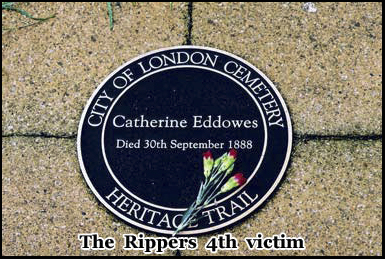 just have the victims name and date of death. Unless you had specific knowledge, you wouldn’t know there were anything to do with Jack the Ripper. Possibly part of the reason for this is that funerals and cremations still take place here, and people may be put off having someone they lost lying next to a the murder victim of a notorious serial killer. About fifteen yards away on the other side of the path, there is a plaque for Catherine Eddowes. It is identical to the other one but sits just to the side of a small tree. One thing to note is that on both of the markers it does say that they are part of the “City of London cemetery heritage trail”, so I assume by this I am not the only one to seek out their locations. Also on each of the graves there were fresh flowers, so a hundred years later like the man that murdered them, they are still remembered.
just have the victims name and date of death. Unless you had specific knowledge, you wouldn’t know there were anything to do with Jack the Ripper. Possibly part of the reason for this is that funerals and cremations still take place here, and people may be put off having someone they lost lying next to a the murder victim of a notorious serial killer. About fifteen yards away on the other side of the path, there is a plaque for Catherine Eddowes. It is identical to the other one but sits just to the side of a small tree. One thing to note is that on both of the markers it does say that they are part of the “City of London cemetery heritage trail”, so I assume by this I am not the only one to seek out their locations. Also on each of the graves there were fresh flowers, so a hundred years later like the man that murdered them, they are still remembered.
As to whom Jack the Ripper was, there are almost thirty suspects, some of them more credible then others. There are dozens of books, videos and websites that still theorize about him to this day. Occasionally new information does come up relating to the case. But it is the very fact that the case remains unsolved that continues to draw people from all over the world to walk the same streets he did.
A Visit To The Murder Sites Of Jack The Ripper – Youtube
The Worlds Largest Repository On Ripper Related Information – Casebook
The Original Walking Tour – Jack The Ripper Tour
The Suspects So Far – The Telegraph
Explore Haunted London – The Ripper Museum
The Genuine Ripper Suspects – The Metropolitan Police
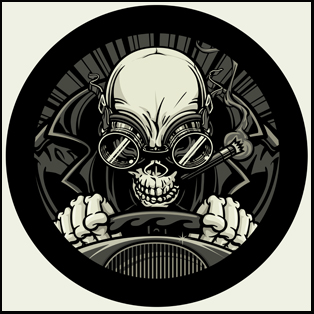

Leave a Reply